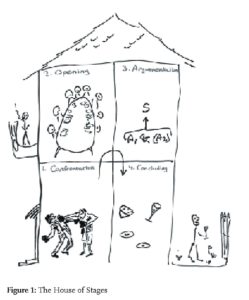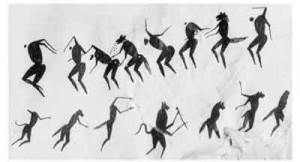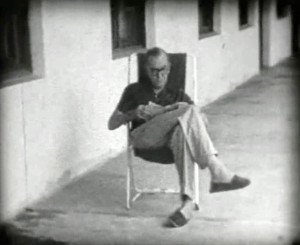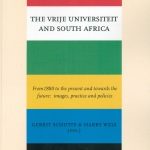ISSA Proceedings 2006 – Ehninger’s Argument Violin
 Douglas Ehninger’s theoretical gem, “Argument as Method” (1970), introduces us to two unsavory debate characters. First, there is the “neutralist” – an interlocutor who eschews commitment at every turn. Following the Greek philosopher Pyrrho, the neutralist thinks that since nothing can be known, standpoints should float freely, unanchored by the tethers of belief. The neutralist’s counterpart is the “naked persuader” – someone who approaches argument like Plato’s Callicles – clinging doggedly to preconceived beliefs and resisting any shift no matter how compelling the counterpoints (Ehninger 1970, p. 104).
Douglas Ehninger’s theoretical gem, “Argument as Method” (1970), introduces us to two unsavory debate characters. First, there is the “neutralist” – an interlocutor who eschews commitment at every turn. Following the Greek philosopher Pyrrho, the neutralist thinks that since nothing can be known, standpoints should float freely, unanchored by the tethers of belief. The neutralist’s counterpart is the “naked persuader” – someone who approaches argument like Plato’s Callicles – clinging doggedly to preconceived beliefs and resisting any shift no matter how compelling the counterpoints (Ehninger 1970, p. 104).
Naked persuaders and neutralists each have difficulty engaging in argument, but for different reasons. According to Ehninger (1970, p. 104), argumentation is a “person risking enterprise,” and by entering into an argument, “a disputant opens the possibility that as a result of the interchange he too may be persuaded of his opponent’s view, or, failing that, at least may be forced to make major alterations in his own.” In this account, naked persuaders are hamstrung by their unwillingness to risk the possibility that the force of reason will prompt alteration of their views. Neutralists, on the other hand, prevent the “person risking enterprise” from ever getting off the ground in the first place, since they place nothing on the table to risk.
Ehninger’s unsavory characters illustrate how the concept of standpoint commitment has salience in any theory of “argument as process” (Wenzel 1990). To reap the full benefits of the process of argumentation, interlocutors must adopt stances vis-à-vis their standpoints that strike an appropriate balance between perspectives of the naked persuader and the neutralist. For Ehninger (1970, p. 104), such a balanced posture consists of “restrained partisanship,” where advocates drive dialectic forward with tentative conviction, while remaining open to the possibility that the course of argument may dictate that their initial standpoints require amendment or retraction. Finding this delicate balance resembles the tuning of violin strings – a metaphor that underscores his point that the proper stance of restrained partisanship must be tailored to fit each situation.
The public argument prior to the 2003 Iraq War offers a clear example of a poorly tuned deliberative exchange. While several official investigations (e.g. US Commission 2005; US Senate 2004) have explained the breakdown in prewar decision-making as a case of faulty data driving bad policy, this paper explores how the technical concept of foreign policy “intelligence failure” (Matthias 2001) can be expanded to offer a more fine-grained explanation for the ill-fated war decision, which stemmed in part from a failure of the argumentative process in public spheres of deliberation. Part one revisits Ehninger’s concept of standpoint commitment, framing it in light of related argumentation theories that address similar aspects of the argumentative process. This discussion paves the way for a case study of public argument concerning the run-up to the 2003 Iraq War. Finally, possible implications of the case study for foreign policy rhetoric and argumentation theory are considered. Read more
ISSA Proceedings 2006 ~ On How To Get Beyond The Opening Stage
1. Introduction
What is the opening stage? And why would it be hard to get beyond it?
The opening stage – as many will know – is one of the four discussion stages contained in the familiar pragma-dialectical model of critical discussion (Van Eemeren & Grootendorst 1984, 1992, 2004), which constitutes a normative model for argumentative activities aimed at the resolution of a difference of opinion. It is one of the merits of this model that, in its description of the ideal argumentative process, it does not limit itself to argumentation in the proper, but narrow, sense of advancing arguments for a standpoint, but includes discussion stages where other necessary steps for the resolution of differences of opinion are located. Remember that there are just four stages, and that they are, in order, the following:
1. Confrontation Stage
2. Opening Stage
3. Argumentation stage
4. Concluding Stage.
Contrary to what may be expected, the opening stage does not figure as the first stage (whereas the concluding stage finds itself indeed neatly placed at the end). This is a vagary of nomenclature that sometimes breeds confusion even among experts. Apart from that, it is clear that the process of argumentation proper has been placed in the third stage, the argumentation stage, and that the first two stages figure as preparatory stages.
The problem I want to discuss actually pertains to both preparatory stages, namely: how can one get them completed, in a satisfactory way and within a reasonable time, to move on to what is properly called argumentation. However I will discuss this problem with special reference to the opening stage.
 To enhance a more lively remembrance of the four stages of discussion you could picture them as a house with four rooms (see Figure 1).
To enhance a more lively remembrance of the four stages of discussion you could picture them as a house with four rooms (see Figure 1).
When guests enter into this house they start on the ground floor in Room 1, a kind of gym – a place suitable for boxing exercises – which represents the confrontation stage, i.e., the stage where a difference of opinion is made explicit. The goal is to get, ultimately, to Room 4, another ground floor room, giving on to the garden, where refreshments are served – drinks and tidbits – which room represents the concluding stage, i.e., the stage where agreements are achieved. Now to get there, our guests have to pass through two other rooms, both on the upper floor, which represent the opening stage (Room 2) and the argumentation stage (Room 3). In Room 3, the actual business of argumentation is going on: for instance, a standpoint S is being supported by argument. But before one gets there, a lot of preparatory work needs to be done. The agenda will be presented in the next section, but one thing that has to be settled is the choice of a system of discussion rules that the parties are going to adhere to. No wonder Room 2 is packed with theorists of argumentation debating these rules. The complexity of issues and the multiplicity of perspectives is making one wonder whether any agreement will ever be reached at all. One would be fortunate to see the people in Room 2 manage to come to an agreement about just the shape of their table. Even that issue can be nasty, as was the case at the opening stage of the Paris Peace Conference about Vietnam. As some will remember, in 1968-69 the shape of the table was debated for months. This, of course, was a case of opening a negotiation dialogue, not a persuasion dialogue or argumentative discussion. Yet, the case of the Paris Peace Conference constitutes a classical illustration of how difficult it may be to get beyond the opening stage of a discussion. (Which is not to say that the issue of the shape of the table was unimportant at the time.)
The rest of this paper will be organized as follows. As I announced before, I shall first present the agenda for Room 2, i.e., a task list for the opening stage, assembled from pragma-dialectic writings (Section 2). Then I shall illustrate these tasks in a dialogue (Section 3), point out some problems (Section 4) and start on some sketch of a way to adapt the architecture of critical discussion in order to overcome these problems (Section 5). Read more
Rock Art Research in South Africa

Therianthropes and trance dance from artwork painted by Kalahari artist, the late Vetkat Regopstaan Kruiper (with permission)
Ethno-archaeology: Oral narratives and rock art
The focus of my research is on the method of recording oral narratives and their link to, and possible use in, the interpretation of rock art, specifically rock engravings. Research on indigenous knowledge and artefacts falls within a contentious area of indigenous archaeology associated with colonialists’ geographic and intellectual imperialism. It is necessary for my contextual approach to include, as in the exploration of myths, the theoretical setting of ethno-archaeology within which my research takes place. In the discipline of archaeology the use of ethnography falls under what Renfrew and Bahn (1991: 339) call ‘What did they think?’ The use of ‘they’ points not only to ethical issues of ‘othering’, the negative artificial construction of two camps of cultures and the corresponding approaches of scholars and present day descendants of the artists, but also to the time gap between the artists of the past and the present (Lewis-Williams & Pearce, 2004).
The rock paintings situated in caves, shelters and on portable stones, mostly in the mountainous regions in South Africa, and rock engravings situated predominantly in the plateau areas, on boulders on hills or near rivers, date mostly from within the last few thousand years. However, small mobiliary painted stones from Apollo 11 Cave and an engraved ochre piece from Blombos Cave date from some 25 000 and up to 70 000 years ago respectively (Lewis-Williams & Pearce, 2004). This considerable antiquity complicates any attempts at interpreting the rock art by way of oral narratives, even those recorded by the earliest colonialists. Furthermore, our views and therefore theories on art, oral narrative and methodology are constantly changing (Bahn, 1998).
Tiny Bouts Of Contentment. Rare Film Footage Of Graham Greene In The Belgian Congo, March 1959
My purpose in this contribution is to present and contextualize the only film footage ever recorded of the novelist Graham Greene (1904-1991) in the Belgian Congo in 1959. The footage was filmed with an 8mm camera, which did not record sound. It belongs to Mrs. Édith Lechat (née Dasnoy;1932-) and her husband, the leprosy specialist Doctor (later Professor) Michel Lechat (1927-2014).
From 1953 through 1960, Dr. Lechat was head of the leper hospital and colony of Iyonda, a village and mission station some 15 kms south of the city of Coquilhatville (now, Mbandaka) in central-western Congo. Greene stayed a number of weeks in Iyonda and other mission stations in the region in search of inspiration, a setting, and material for a new novel. The novel, A Burnt-Out Case, appeared in 1960, and was dedicated to Dr. Lechat. Greene occupied a room in the house of the missionary fathers in Iyonda, but spent long parts of his days with the doctor and his family. The film reached me through the hands of Édith Lechat, who had it transposed to a DVD-playable format, and via my friend Hendrik (a.k.a., “Henri” or “Rik”) Vanderslaghmolen (1921-), who was a missionary in the region at the time. As he was one of the only Belgian missionaries there with some knowledge of English, he often accompanied Graham Greene during his trips from one mission station to another. Rik Vanderslaghmolen and the Lechats are still close friends today.
Much of the information I offer below stems from conversations I had with both Rik Vanderslaghmolen and Édith Lechat in July and August 2013. Regrettably, Dr. Michel Lechat’s poor health condition did not allow me to probe his memory, but an interview he gave for the Brussels-based weekly The Bulletin on the occasion of Greene’s death in 1991 is available (Lechat 1991), as well as a closely similar talk he gave at the 2006 Graham Greene Festival in Berkhamsted, published in the London Review of Books in August 2007 (Lechat 2007). Édith Lechat has given me the kind permission to share the film with the readership of Rozenberg Quarterly and to add the necessary contextual information on both the historical situation and the contents of the film.
Diversity Education: Lessons For A Just World
 Multicultural education, intercultural education, nonracial education, antiracist education, culturally responsive pedagogy, ethnic studies, peace studies, global education, social justice education, bilingual education, mother tongue education, integration – these and more are the terms used to describe different aspects of diversity education around the world. Although it may go by different names and speak to stunningly different conditions in a variety of sociopolitical contexts, diversity education attempts to address such issues as racial and social class segregation, the disproportionate achievement of students of various backgrounds, and the structural inequality in both schools and society. In this paper, I consider the state of diversity education, in broad strokes, in order to draw some lessons from its conception and implementation in various countries, including South Africa. To do so, I consider such issues as the role of asymmetrical power relations and the influence of neoliberal and neoconservative educational agendas, among others, on diversity education. I also suggest a number of lessons learned from our experiences in this field in order to think about how we might proceed in the future, and I conclude with observations on the role of teachers in the current socio-political context.
Multicultural education, intercultural education, nonracial education, antiracist education, culturally responsive pedagogy, ethnic studies, peace studies, global education, social justice education, bilingual education, mother tongue education, integration – these and more are the terms used to describe different aspects of diversity education around the world. Although it may go by different names and speak to stunningly different conditions in a variety of sociopolitical contexts, diversity education attempts to address such issues as racial and social class segregation, the disproportionate achievement of students of various backgrounds, and the structural inequality in both schools and society. In this paper, I consider the state of diversity education, in broad strokes, in order to draw some lessons from its conception and implementation in various countries, including South Africa. To do so, I consider such issues as the role of asymmetrical power relations and the influence of neoliberal and neoconservative educational agendas, among others, on diversity education. I also suggest a number of lessons learned from our experiences in this field in order to think about how we might proceed in the future, and I conclude with observations on the role of teachers in the current socio-political context.
Read more
Edutainment Radio Programmes
 The ways in which journalists frame HIV stories can strongly contribute towards news consumers’ perceptions of the epidemic. This paper discusses the news values of HIV radio programmes in Ethiopia, Kenya and South Africa. It argues that the culturally appropriate ‘humanisation’ of HIV stories and the proper use of conflict as adding news value are paramount to the impact of stories.
The ways in which journalists frame HIV stories can strongly contribute towards news consumers’ perceptions of the epidemic. This paper discusses the news values of HIV radio programmes in Ethiopia, Kenya and South Africa. It argues that the culturally appropriate ‘humanisation’ of HIV stories and the proper use of conflict as adding news value are paramount to the impact of stories.
The skillful application of news values can make almost any HIV-related story newsworthy and therefore part of mainstream news. Moreover, it is maintained that HIV advocacy environments contribute to the newsworthiness of HIV stories in the media.
The AIDS advocacy milieus of South Africa and Kenya are compared and related to the type of HIV stories that are published and broadcast in the respective countries. Journalism training methods are critically discussed in the context of the above. It is argued, that, in developing countries, where journalists often lack basic journalism skills, it is not sufficient to provide reporters with HIV-related information; HIV information sharing should be combined with general journalism training and mentoring.
Introduction
In December 2007, an excited Bashir Osman – a Somaligna-speaking journalist from Dire Dawa in the east of Ethiopia – broadcast a live call-in show on breastfeeding and HIV to his Somali audience on Dire 106.1 FM. According to the most recent Ethiopian government figures, Dire Dawa has the second highest HIV prevalence rate in the country, and almost doubles the national average. Each year there are almost 1, 000 HIV positive pregnancies with at least 230 children born with the virus. Yet this was the first HIV programme that Bashir had ever produced. AIDS was so stigmatised in the region that Dire 106.1 FM hardly ever discussed it on air. And Osman had no problem following this route. A week before the broadcast, the journalist – like most of his listeners – refused to be in the same room as people with HIV because he “didn’t want to risk breathing the same air” (Osman cited in De Masi, 2008) as them. He would never consider sharing a plate, or hosting an HIV positive person in his home, and thought it a deep insult to be tested for the virus.
But then Osman accessed what turned out to be a precious piece of culturally relevant information: he learned that babies of HIV positive women can get infected with the virus through their mothers’ breast milk (personal communication, December 6, 2007). All mothers with babies in his community breastfed their infants x including his very own wife. His own five-month old baby could be at risk, he perceived with shock, because neither he nor his wife knew their HIV status. The realisation changed Osman’s entire view on AIDS, and HIV was suddenly a virus that had the potential to directly impact his own life and those of everyone else he knew, in ways he had previously vehemently denied (personal communication, December 6, 2007). In short, this piece of information made AIDS newsworthy to Osman, his community and his editors. It became something that was crucial and worthwhile to talk about.
HIV and the News Media
Several communication experts, AIDS activists and journalists (Collins, 2005; Kinsella, 1989; Malan & Gold, 2006; Scalway, 2003; Shilts, 1987) have argued that the news media have the potential to be an immensely powerful tool in the response to HIV. According to the Joint United Nations Programme on HIV/AIDS Executive Director (UNAIDS), dr. Peter Piot, “journalists can save more lives than doctors in terms of HIV prevention because preventing HIV is about communication and changing norms” (Piot, 2006).
Proving statements like this, however, is very complex; studies have not been able to conclusively show that stories in the news media have resulted in change in HIV-related behaviour on a large scale. Research has, however, strongly suggested that news stories are capable of setting the framework in which citizens discuss public events. McCombs and Shaw (1972) demonstrated that there was a strong relation between the topics that the news media highlighted during an American election campaign and the topics that news consumers identified as important. Another US study illustrated the power of broadcast news to set the policy agenda when it proved that evening news bulletins had the effect of defining the policy areas by which the president should be judged (Iyengar et al., 1984).
McCombs and Ghanem (2001) have argued that “the level degree of emphasis placed on issues in the mass media influences the priority accorded these issues by the public” (cited in Reese, Gandy & Grant, 2001, p. 67). Dearing and Rogers (1996) stated that this proposition had been supported by more than 200 studies. But, I would argue that the regular publishing or airing of stories on a certain subject does necessarily lead to the public taking note of that subject. If such stories do not directly relate to the lives of readers or broadcast audiences, or are not presented in captivating ways with strong news values, they are unlikely to influence news consumers’ opinions – whether negatively or positively. In the case of a highly stigmatised and sensitive subject such as HIV/AIDS, even more so. Read more



